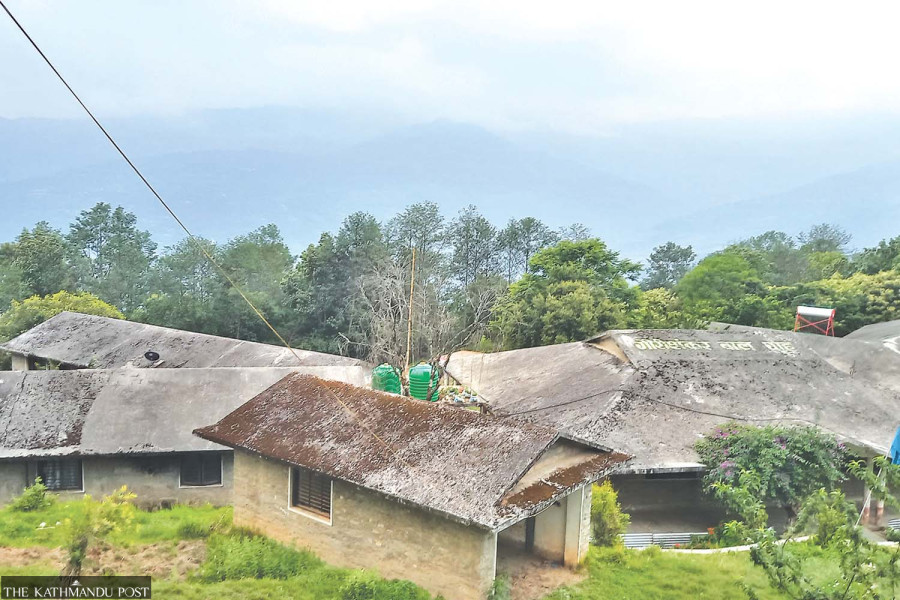Bagmati Province
Dolakha children’s home damaged by 2015 quakes remains in dilapidated condition, nine years later
All five buildings of the Gaurishankar Children’s Home, which houses 17 children, have developed cracks, the roofs leak, and children live in fear.
Kedar Shiwakoti
The earthquake-damaged buildings of Gaurishankar Children’s Home in Dolakha have yet to be repaired or retrofitted. The walls and roofs developed cracks during the 2015 earthquakes, and water leaks through the roofs when it rains. The dormitories are dark and poorly furnished.
As many as 17 children, aged 5 to 17 years, have been living in the dilapidated structures risking their lives. “Water leaks from the concrete roofs whenever it rains. We have to stay in damp rooms. We don’t know when the roof will collapse,” said Santosh Bohara, who is taking shelter in the children’s home. According to him, the children shiver, mainly in winter, as the buildings do not have window panes and they don’t have warm and good bedding materials.
The children’s home does not have basic logistics and even the stationery for the kids. They get up early in the morning, take a meal and rush to school—Mahendrodaya Secondary School in Mati. They have to walk downhill for about 45 minutes to reach the community school. The children return in the evening hungry and exhausted as they have to walk around one hour.
The children’s home is located in ward 5 of Bhimeshwar Municipality, near Dolakha’s district headquarters Charikot. The home is spread over 29 ropani (1.48 hectares) of land. There are five buildings, but all of them are on the verge of collapse.
The infrastructures of the children’s home were constructed with Dutch financial assistance in 1996 with an objective of providing shelter and education to the helpless and needy children. The then acting prime minister and labour minister Bal Bahadur Rai had inaugurated the children’s home.
Seventeen needy children from Dolakha, Rolpa, Kalikot and Humla have been currently taking shelter in the children’s home which is one of the spacious infrastructures under Nepal Children’s Organisation. The children’s home was initially managed by the Dutch government for about 10 years. The children’s home got mired in multiple problems after it was handed over to the Nepal Children’s Organisation.
“We don’t have problems regarding food. But we live in constant fear due to the dilapidated condition of the buildings. The small children are hugely affected. They often fall ill with cold-related diseases due to the poor condition of the buildings,” said Santosh. According to him, the children have to endure mosquito-bites because the buildings do not have window panes.

Gaurishankar Children’s Home was the model children’s home in the past. Up to 150 children took shelter in the home. But it is now in a pathetic condition. It does not have a compound wall, and the children complain that the goods provided by the donors, as well as food, are stolen by outsiders due to the lack of security.
The children’s home does not have educational and sports materials. There is a small television set in a room and the children have to sit on the cold floor. The children do not have umbrellas as a result they cannot go to school during the rainy season. “We have to get wet in the rain or skip class because we don’t have umbrellas. We leave our books and other materials at school and return drenched if it rains after school,” said Asmit Dhungel, another child staying in the children’s home.
It has been more than nine years since the devastating earthquake, but the authorities concerned are indifferent to repairing or reconstructing the quake-ravaged buildings of the children’s home. “We are compelled to keep the children under the dilapidated buildings. Mild tremors and aftershocks are still occurring. We stay in the open space during such tremors,” said Ram Prasad Sapkota, Dolakha chairman of the Nepal Children’s Organisation. He complained that the state has not prioritised the reconstruction of the children’s home.
“Other schools having just 10-15 students have already been reconstructed in the district. But the government is indifferent to reconstructing the children’s home that provides shelter and education to the helpless and needy children,” said Sapkota. “We urged various authorities for the reconstruction, but they did not take any initiatives. The children are forced to stay in the risky buildings due to the government's apathy,” he lamented.
According to the officials at Bhimeshwar Municipality, Gaurishankar Children’s Home was left out when the federal government carried out a study for the reconstruction of educational institutions and private houses after the 2015 earthquake. “The local unit is also responsible for taking initiatives for the reconstruction of the children’s home. We will soon determine whether the children’s home needs to be reconstructed or repaired. We will submit a report to the provincial and federal governments if the municipality’s budget is not enough for the reconstruction,” said Suresh Raut, chief engineer at the planning unit of Bhimeshwar Municipality.




 9.12°C Kathmandu
9.12°C Kathmandu













